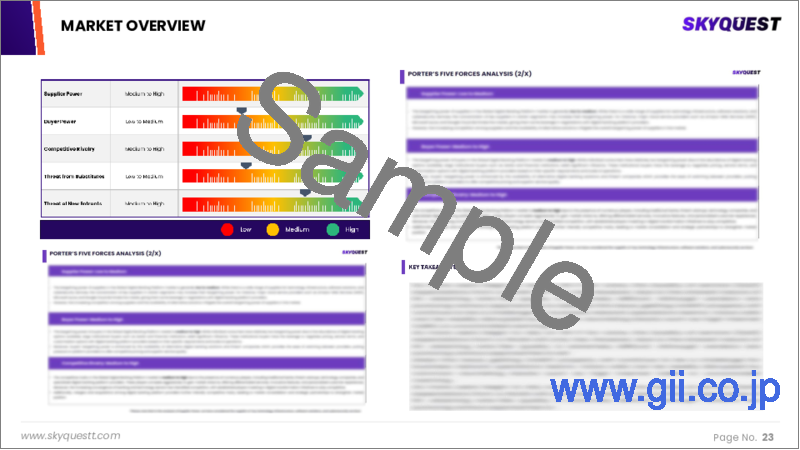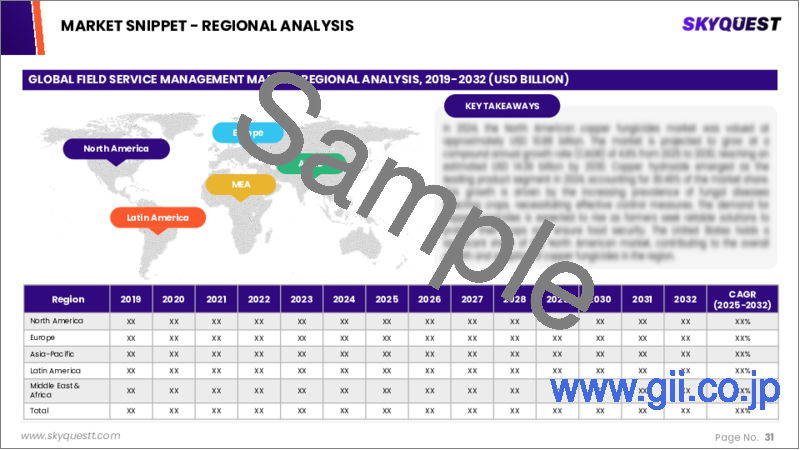|
|
市場調査レポート
商品コード
1624057
フィールドサービス管理(FSM)の市場規模、シェア、成長分析、オファリング別、展開モード別、組織規模別、業界別、地域別 - 産業予測、2025~2032年Field Service Management (FSM) Market Size, Share, Growth Analysis, By Offering (Solutions, Services), By Deployment Mode (Cloud, On-premises), By Organization Size, By Vertical, By Region - Industry Forecast 2025-2032 |
||||||
|
|||||||
| フィールドサービス管理(FSM)の市場規模、シェア、成長分析、オファリング別、展開モード別、組織規模別、業界別、地域別 - 産業予測、2025~2032年 |
|
出版日: 2025年01月03日
発行: SkyQuest
ページ情報: 英文 157 Pages
納期: 3~5営業日
|
全表示
- 概要
- 目次
フィールドサービス管理(FSM)の世界市場規模は2023年に39億6,000万米ドルと評価され、予測期間(2025-2032年)のCAGRは12.7%で、2024年の44億6,000万米ドルから2032年には116億1,000万米ドルに成長する見通しです。
世界のフィールドサービス管理(FSM)市場は、進化する消費者の期待、技術革新、効率的なサービス提供の必要性によって大きな成長を遂げています。企業は、顧客サポートを強化しながら生産性を高め、業務を合理化するために、FSMソリューションの採用を増やしています。この市場の主要動向は、AI、ML、IoTなどの先進技術の統合であり、これにより予知保全とインテリジェント・スケジューリングが可能になります。さらに、クラウドベースのFSMプラットフォームは、費用対効果、拡張性、既存システムとの互換性により人気を集めています。また、卓越した顧客体験を重視する傾向が強まっていることも、現場技術者が重要なデータにリアルタイムでアクセスできるモバイルアクセス可能なFSMシステムの採用の動機となっています。しかし、競争が激化する中、統合の複雑さやスキル不足といった課題は依然として残っています。
目次
イントロダクション
- 調査の目的
- 調査範囲
- 定義
調査手法
- 情報調達
- 二次データと一次データの方法
- 市場規模予測
- 市場の前提条件と制限
エグゼクティブサマリー
- 世界市場の見通し
- 供給と需要の動向分析
- セグメント別機会分析
市場力学と見通し
- 市場概要
- 市場規模
- 市場力学
- 促進要因と機会
- 抑制要因と課題
- ポーターの分析
主な市場の考察
- 重要成功要因
- 競合の程度
- 主な投資機会
- 市場エコシステム
- 市場の魅力指数(2024年)
- PESTEL分析
- マクロ経済指標
- バリューチェーン分析
- 価格分析
- 特許分析
- 技術分析
- ケーススタディ
- 規制分析
フィールドサービス管理(FSM)市場規模:オファリング別
- 市場概要
- ソリューション
- スケジュールディスパッチルート最適化
- 顧客管理
- 作業指示管理
- 在庫管理
- サービス契約管理
- レポートと分析
- その他のソリューション
- サービス
- コンサルティング
- 統合と実装
- トレーニングとサポート
フィールドサービス管理(FSM)市場規模:展開モード別
- 市場概要
- クラウド
- オンプレミス
フィールドサービス管理(FSM)市場規模:組織規模別
- 市場概要
- 大企業
- 中小企業
フィールドサービス管理(FSM)市場規模:業界別
- 市場概要
- 通信
- ITとITeS
- ヘルスケアとライフサイエンス
- 製造業
- 運輸・物流
- 建設・不動産
- エネルギー・公益事業
- 石油・ガス
- その他の業種
フィールドサービス管理(FSM)市場規模
- 北米
- 米国
- カナダ
- 欧州
- ドイツ
- スペイン
- フランス
- 英国
- イタリア
- その他欧州地域
- アジア太平洋地域
- 中国
- インド
- 日本
- 韓国
- その他アジア太平洋地域
- ラテンアメリカ
- ブラジル
- その他ラテンアメリカ地域
- 中東・アフリカ
- GCC諸国
- 南アフリカ
- その他中東・アフリカ
競合情報
- 上位5社の比較
- 主要企業の市場ポジショニング(2024年)
- 主な市場企業が採用した戦略
- 市場の最近の動向
- 企業の市場シェア分析(2024年)
- 主要企業の企業プロファイル
- 会社概要
- 製品ポートフォリオ分析
- セグメント別シェア分析
- 収益の前年比比較(2022-2024)
主要企業プロファイル
- Oracle
- Microsoft
- SAP
- IFS
- ServiceMax
- Salesforce
- Infor
- Trimble
- Comarch
- ServicePower
- ServiceNow
- Overit
- FieldAware
- Zinier
- Accruent
- Praxedo
- FieldEZ
- FieldEdge
- Jobber
- ServiceTitan
結論と推奨事項
Global Field Service Management (FSM) Market size was valued at USD 3.96 billion in 2023 and is poised to grow from USD 4.46 billion in 2024 to USD 11.61 billion by 2032, growing at a CAGR of 12.7% during the forecast period (2025-2032).
The global Field Service Management (FSM) Market is witnessing significant growth driven by evolving consumer expectations, technological innovations, and the need for efficient service delivery. Companies are increasingly adopting FSM solutions to boost productivity and streamline operations while enhancing customer support. A key trend in this market is the integration of advanced technologies like AI, ML, and IoT, which enable predictive maintenance and intelligent scheduling. Moreover, cloud-based FSM platforms are gaining popularity due to their cost-effectiveness, scalability, and compatibility with existing systems. The increased focus on exceptional customer experiences is also motivating the adoption of mobile-accessible FSM systems that allow field technicians real-time access to essential data. However, challenges such as integration complexities and skill shortages persist, amidst fierce competition.
Top-down and bottom-up approaches were used to estimate and validate the size of the Global Field Service Management (FSM) Market and to estimate the size of various other dependent submarkets. The research methodology used to estimate the market size includes the following details: The key players in the market were identified through secondary research, and their market shares in the respective regions were determined through primary and secondary research. This entire procedure includes the study of the annual and financial reports of the top market players and extensive interviews for key insights from industry leaders such as CEOs, VPs, directors, and marketing executives. All percentage shares split, and breakdowns were determined using secondary sources and verified through Primary sources. All possible parameters that affect the markets covered in this research study have been accounted for, viewed in extensive detail, verified through primary research, and analyzed to get the final quantitative and qualitative data.
Global Field Service Management (FSM) Market Segmental Analysis
Global Field Service Management (FSM) Market is segmented by Offering, Deployment Mode, Organization Size, Vertical and region. Based on Offering, the market is segmented into Solutions and Services. Based on Deployment Mode, the market is segmented into Cloud and On-premises. Based on Organization Size, the market is segmented into Large Enterprises and SMEs. Based on Vertical, the market is segmented into Telecom, IT & ITeS, Healthcare & Life Sciences, Manufacturing, Transportation & Logistics, Construction & Real Estate, Energy & Utilities, Oil & Gas and Other Verticals. Based on region, the market is segmented into North America, Europe, Asia Pacific, Latin America and Middle East & Africa.
Driver of the Global Field Service Management (FSM) Market
A key driver of the Global Field Service Management (FSM) Market is the increasing adoption of mobile-based FSM solutions. These technologies enable technicians to document service activities, track work orders, and manage their schedules directly from their smartphones or tablets. This not only reduces administrative workload but also enhances productivity, allowing professionals to focus more on delivering exceptional customer service. Furthermore, mobile FSM solutions facilitate real-time communication and collaboration among field personnel, dispatchers, and back-office staff, resulting in improved operational efficiency and faster job completion. Ultimately, the convenience and effectiveness of mobile FSM tools are propelling their widespread adoption across the industry.
Restraints in the Global Field Service Management (FSM) Market
The Global Field Service Management (FSM) Market faces notable constraints due to organizational security concerns surrounding data confidentiality. Companies handling sensitive client information, operational data, and intellectual property are increasingly anxious about potential data breaches that could result in unauthorized access. Such security incidents can lead to severe repercussions, including financial losses, reputational harm, and legal liabilities. Furthermore, organizations must navigate stringent regulations regarding data protection, including compliance with laws like HIPAA and GDPR, which complicates their operations. The scrutiny associated with these regulations adds an additional layer of challenge, prompting organizations to prioritize robust security measures to mitigate risks.
Market Trends of the Global Field Service Management (FSM) Market
The Global Field Service Management (FSM) Market is witnessing a significant trend towards cost-effective, flexible, and transparent solutions, primarily due to the growing adoption of cloud-based FSM systems. As organizations embrace these platforms, they benefit from enhanced cost efficiencies and operational agility, allowing for seamless communication and collaboration between home office teams and field personnel. This shift enables companies to respond more swiftly to customer demands, optimize resource allocation, and improve service delivery. As a result, businesses are increasingly prioritizing cloud technology in their FSM strategies, leading to a robust growth trajectory in the global market, projected to continue into the coming years.
Table of Contents
Introduction
- Objectives of the Study
- Scope of the Report
- Definitions
Research Methodology
- Information Procurement
- Secondary & Primary Data Methods
- Market Size Estimation
- Market Assumptions & Limitations
Executive Summary
- Global Market Outlook
- Supply & Demand Trend Analysis
- Segmental Opportunity Analysis
Market Dynamics & Outlook
- Market Overview
- Market Size
- Market Dynamics
- Drivers & Opportunities
- Restraints & Challenges
- Porters Analysis
- Competitive rivalry
- Threat of substitute
- Bargaining power of buyers
- Threat of new entrants
- Bargaining power of suppliers
Key Market Insights
- Key Success Factors
- Degree of Competition
- Top Investment Pockets
- Market Ecosystem
- Market Attractiveness Index, 2024
- PESTEL Analysis
- Macro-Economic Indicators
- Value Chain Analysis
- Pricing Analysis
- Patent Analysis
- Technology Analysis
- Case Studies
- Regulatory Analysis
Global Field Service Management (FSM) Market Size by Offering & CAGR (2025-2032)
- Market Overview
- Solutions
- Scheduling, Dispatch, & Route Optimization
- Customer Management
- Work Order Management
- Inventory Management
- Service Contract Management
- Reporting and Analytics
- Other Solutions
- Services
- Consulting
- Integration & Implementation
- Training & Support
Global Field Service Management (FSM) Market Size by Deployment Mode & CAGR (2025-2032)
- Market Overview
- Cloud
- On-premises
Global Field Service Management (FSM) Market Size by Organization Size & CAGR (2025-2032)
- Market Overview
- Large Enterprises
- SMEs
Global Field Service Management (FSM) Market Size by Vertical & CAGR (2025-2032)
- Market Overview
- Telecom
- IT & ITeS
- Healthcare & Life Sciences
- Manufacturing
- Transportation & Logistics
- Construction & Real Estate
- Energy & Utilities
- Oil & Gas
- Other Verticals
Global Field Service Management (FSM) Market Size & CAGR (2025-2032)
- North America (Offering, Deployment Mode, Organization Size, Vertical)
- US
- Canada
- Europe (Offering, Deployment Mode, Organization Size, Vertical)
- Germany
- Spain
- France
- UK
- Italy
- Rest of Europe
- Asia Pacific (Offering, Deployment Mode, Organization Size, Vertical)
- China
- India
- Japan
- South Korea
- Rest of Asia-Pacific
- Latin America (Offering, Deployment Mode, Organization Size, Vertical)
- Brazil
- Rest of Latin America
- Middle East & Africa (Offering, Deployment Mode, Organization Size, Vertical)
- GCC Countries
- South Africa
- Rest of Middle East & Africa
Competitive Intelligence
- Top 5 Player Comparison
- Market Positioning of Key Players, 2024
- Strategies Adopted by Key Market Players
- Recent Developments in the Market
- Company Market Share Analysis, 2024
- Company Profiles of All Key Players
- Company Details
- Product Portfolio Analysis
- Company's Segmental Share Analysis
- Revenue Y-O-Y Comparison (2022-2024)
Key Company Profiles
- Oracle
- Company Overview
- Business Segment Overview
- Financial Updates
- Key Developments
- Microsoft
- Company Overview
- Business Segment Overview
- Financial Updates
- Key Developments
- SAP
- Company Overview
- Business Segment Overview
- Financial Updates
- Key Developments
- IFS
- Company Overview
- Business Segment Overview
- Financial Updates
- Key Developments
- ServiceMax
- Company Overview
- Business Segment Overview
- Financial Updates
- Key Developments
- Salesforce
- Company Overview
- Business Segment Overview
- Financial Updates
- Key Developments
- Infor
- Company Overview
- Business Segment Overview
- Financial Updates
- Key Developments
- Trimble
- Company Overview
- Business Segment Overview
- Financial Updates
- Key Developments
- Comarch
- Company Overview
- Business Segment Overview
- Financial Updates
- Key Developments
- ServicePower
- Company Overview
- Business Segment Overview
- Financial Updates
- Key Developments
- ServiceNow
- Company Overview
- Business Segment Overview
- Financial Updates
- Key Developments
- Overit
- Company Overview
- Business Segment Overview
- Financial Updates
- Key Developments
- FieldAware
- Company Overview
- Business Segment Overview
- Financial Updates
- Key Developments
- Zinier
- Company Overview
- Business Segment Overview
- Financial Updates
- Key Developments
- Accruent
- Company Overview
- Business Segment Overview
- Financial Updates
- Key Developments
- Praxedo
- Company Overview
- Business Segment Overview
- Financial Updates
- Key Developments
- FieldEZ
- Company Overview
- Business Segment Overview
- Financial Updates
- Key Developments
- FieldEdge
- Company Overview
- Business Segment Overview
- Financial Updates
- Key Developments
- Jobber
- Company Overview
- Business Segment Overview
- Financial Updates
- Key Developments
- ServiceTitan
- Company Overview
- Business Segment Overview
- Financial Updates
- Key Developments





